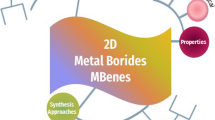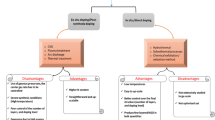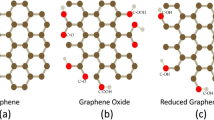Abstract
We have performed a Density Functional study of the CO adsorption in B-doped, N-doped and BN-co-doped graphene considering a coronene based model in order to estimate the applications of this systems as CO-sensor. Different monosubstituted, disubstituted and trisubstituted alternatives of combining these two heteroatoms in a substitutional chemical doping and the influence of the relative positions of the heteroatoms are analyzed. In this study, the stability selectivity for CO adsorption and the change in the electric properties for the presence of this molecule, have been evaluated through the calculation of binding energy, CO-adsorption’s energy and the gap HOMO-LUMO change due to CO adsorption. The results indicated that, even though all the configurations were stables and was confirmed a CO physical adsorption in all of them, the relative positions of Nitrogen and Boron gave different stabilities and different responses to the CO adsorption. Since monosubstituted Boron-coronene was the second in stability respect to pristine coronene, showed the highest CO adsorption energy and was also the second highest ∆(∆HOMO-LUMO) value, this structure could be potentially a good CO-sensor.








Similar content being viewed by others
References
Novoselov KS, Geim AK, Morozov SV et al (2004) Electric field in atomically thin carbon films. Science 306:666–669
Lee C, Wei X, Kysar JW, Hone J (2008) Measurement of the elastic properties and intrinsic strength of monolayer grapheme. Science 321:385–388
Neto AHC, Guinea F, Peres NMR, Novoselov KS, Geim AK (2009) The electronic properties of grapheme. Rev Mod Phys 81:109–162
Morozov SV, Novoselov KS, Katsnelson MI et al (2008) Giant intrinsic carrier mobilities in graphene and its bilayer. Phys Rev Lett 100:016602
Mukherjee S, Kaloni TP (2012) Electronic properties of boron- and nitrogen-doped graphene: a first principles study. J Nanopart Res 14:1059–1063
Lu G, Yu K, Wen Z, Chen J (2013) Semiconducting graphene: converting graphene from semimetal to semiconductor. Nanoscale 5:1353–1368
Usachov D, Vilkov O, Grneis A, Haberer D, Fedorov A, Adamchuk VK, Preobrajenski AB, Dudin P, Barinov A, Oehzelt M, Laubschat C, Vyalikh DV (2011) Nitrogen-doped graphene: efficient growth, structure, and electronic properties. Nano Lett 11:5401–5407
Yu W, Zheng C, Wang D, Jiang Q (2010) Nitrogen/boron doping position dependence of the electronic properties of a triangular graphene. ACS Nano 4:7619–7629
Zheng B, Hermet P, Henrard L (2010) Scanning tunneling microscopy simulations of nitrogen- and boron-doped graphene and single-walled carbon nanotubes. ACS Nano 4:4165–4173
Wang X, Sun G, Routh P, Kim DH, Huang W, Chen P (2014) Heteroatom-doped graphene materials: syntheses, properties and applications. Chem Soc Rev 43:7067–7098
Wei D, Liu Y, Wang Y, Zhang H, Huang L, Yu G (2009) Synthesis of N-doped graphene by chemical vapor deposition and its electrical properties. Nano Lett 9:1752–1758
Fan X, Shen Z, Liu AQ, Kuo JL (2012) Band gap opening of graphene by doping small boron nitride domains. Nanoscale 4:2157–2165
Yang GH, Zhou YH, Wu JJ, Cao JT, Li LL, Liu HY, Zhu JJ (2013) Microwave-assisted synthesis of nitrogen and boron co- doped graphene and its application for enhanced electrochemical detection of hydrogen peroxide. RSC Adv 3:22597–22604
Kaloni TP, Joshi RP, Adhikari NP, Schwingenschlögl U (2014) Band gap Tunning in BN-doped graphene systems with high carrier mobility. Appl Phys Lett 104:073116
Panchakarla LS, Subrahmanyam KS, Saha SK, Achutharao G, Krishnamurthy HR, Waghmare UV, Rao CNR (2009) Synthesis, structure, and properties of boron- and nitrogen-doped graphene. Adv Mater 21:1521–4095
Rani P, Jindal VK (2013) Designing band gap of by B and NDopant atoms. RSC Adv 3:802–812
Yang F, Cao Y, Chen Z, He X, Hou L, Li Y (2018) Large-scale preparation of B/N co-doped graphene-like carbon as an efficient metal-free catalyst for the reduction of nitroarenes. New J Chem 42:2718–2725
Wei XL, Fang H, Wang RZ, Chen YP, Zhong JX (2011) Energy gaps in nitrogen delta-doping graphene: a first-principles study. Appl Phys Lett 99:012107
Deifallah M, McMillan PF, Cora F (2008) Electronic and structural properties of two-dimensional carbon nitride graphenes. J Phys Chem C 112:5447–5453
Allen MJ, Tung VC, Kaner RB (2010) Honeycomb carbon: a review of graphene. Chem Rev 110:132–145
Yavari F, Koratkar N (2012) Graphene-based chemical sensors. J Phys Chem Lett 3:1746–1753
Jelolaica L, Sidis V (1999) DFT investigation of the adsorption of atomic hydrogen on a cluster-model graphite surface. Chem Phys Lett 300:157–162
Schedin F, Geim AK, Morozov SV, Hill EW, Blake P, Katsnelson MI, Novoselov KS (2007) Detection of individual gas molecules adsorbed on grapheme. Nat Mater 6:652–655
Qazi M, Vogt T, Koley G (2007) Trace gas detection using nanostructured graphite layers. Appl Phys Lett 91:233101
Kochmann S, Hirsch T, Wolfbeis OS (2012) Graphenes in chemical sensors and biosensors. Trends Anal Chem 39:87–113
Zhang X, Cui H, Gui CY (2017) Synthesis of graphene-based sensors and application on detecting SF6 decomposing products: a review. Sensors 17:363
Goldoni A, Larciprete R, Petaccia L, Lizzit S (2003) Single-Wall carbon nanotube interaction with gases: sample contaminants and environmental monitoring. J Am Chem Soc 125:11329–11333
Choudhuri N, Patra A, Mahata R, Ahuja BP (2015) B-N@ graphene: highly sensitive and selective gas sensor. J Phys Chem C 119:24827–24836
Dai J, Giannozzi P, Yuan J (2009) Adsorption of pairs of NOx molecules on single-walled carbon nanotubes and formation of NO + NO3 from NO2. Surf Sci 603:3234
Dai J, Yuan J, Giannozzi P (2009) Gas adsorption on graphene doped with B, N, Al, and S: a theoretical study. App Phys Lett 95:232105
Wang T, Huang D, Yang Z, Xu S, He G, Li X, Hu N, Yin G, He D, Zhang L (2016) A review on graphene-based gas/vapor sensors with unique properties and potential applications. Nano-Micro Lett 8(2):95–119
Joshi RK, Gomez H, Alvi F, Kumar A (2010) Graphene films and ribbons for sensing of O2, and 100 ppm of CO and NO2 in practical conditions. J Phys Chem C 114:6610–6613
Arsat R, Breedon M, Shafiei M, Spizziri PG, Gilje S, Kaner RB, Kalantar-Zadeh K, Wlodarski W (2009). Chem Phys Lett 467:344
Ao ZM, Yang J, Li S, Jiang Q (2008) Enhancement of CO detection in Al doped graphene. Chem Phys Lett 461:276–279
Rad AS, Shabestarib SS, Jafaric SA, Zardoostd MR, Mirabid A (2016) N-doped graphene as a nanostructure adsorbent for carbon monoxide: DFT calculations. Mol Phys 1362:3028
Kumar S, Meenakshi, Sharma H (2017) Effect of gas adsorption on graphene nanoribbons: a density functional theory. Mater Today Proc 4:10441–10445
Zhang YH, Chen YB, Zhou KG, Liu CH, Zeng J, Zhang HL, Peng Y (2009) Improving gas sensing properties of graphene by introducing dopants and defects: a first-principles study. Nanotechnology 20:185504
Rohini K, Daniel MRS, Swathi SR (2015) Intercalation of HF, H2O, and NH3 clusters within the bilayers of graphene and graphene oxide: predictions from coronene-based model systems. Phys Chem A 119:10935–10945
Yeamin MB, Faginas-Lago N, Albert E, Cuesta IG, Sanchez-Marín J, Sánchez de Merás AMJ (2014) Multi-scale theoretical investigation of molecular hydrogen adsorption over graphene: coronene as a case study. RSC Adv 4:54447–54453
Wilson J, Faginas-Lago N, Vekeman J, Cuesta IG, Sánchez-Marín J, Sánchez de Merás A (2018) Modeling the interaction of carbon monoxide with flexible graphene: from coupled cluster calculations to molecular-dynamics simulations. Chem Phys Chem 19:774–783
Petrushenko IK, Petrushenko KB (2017) Physical adsorption of N-containing heterocycles on graphene-like boron nitride-carbon heterostructures: a DFT study. Comput Theor Chem 1117:162–168
Rad AS, Shabestari SS, Mohseni S, Aghouzi SA (2016) Study on the adsorption properties of O3, SO2, and SO3 on B-doped graphene using DFT calculations. J Solid State Chem 237:204–210
Wanno B, Tabtimsai C (2014) A DFT investigation of CO adsorption on VIIIB transition metal-doped graphene sheets. Superlattice Microst 67:110–117
Chigo-Anota E, Salazar-Villanueva M, Hernandez-Cocoletzi H (2010) Density functional theory study of lithium and fluoride doped boron nitride sheet. Phys State Solid C 7:2559
Lee C, Wei X, Kysar JW, Hone J (2008) Measurement of the elastic properties and intrinsic strength of monolayer graphene. Science 321:385–388
Frisch MJ, Trucks GW, Schlegel HB, Scuseria GE, Robb MA, Cheeseman JR, Scalmani G, Barone V, Mennucci B, Petersson GA, Nakatsuji H, Caricato M, Li X, Hratchian HP, Izmaylov AF, Bloino J, Zheng G, Sonnenberg JL, Hada M, Ehara M, Toyota K, Fukuda R, Hasegawa J, Ishida M, Nakajima T, Honda Y, Kitao O, Nakai H, Vreven T, Montgomery JA, Peralta JE, Ogliaro F, Bearpark M, Heyd JJ, Brothers E, Kudin KN, Staroverov VN, Kobayashi R, Normand J, Raghavachari K, Rendell A, Burant JC, Iyengar SS, Tomasi J, Cossi M, Rega N, Millam JM, Klene M, Knox JE, Cross JB, Bakken V, Adamo C, Jaramillo J, Gomperts R, Stratmann RE, Yazyev O, Austin AJ, Cammi R, Pomelli C, Ochterski JW, Martin RL, Morokuma K, Zakrzewski VG, Voth GA, Salvador P, Dannenberg JJ, Dapprich S, Daniels AD, Farkas O, Foresman JB, Ortiz JV, Cioslowski J, Fox DJ (2009) Gaussian 09. Gaussian, Inc Wallingford CT
Burke K, Perdew JP, Levy M (1995) In: Seminario JM, Politzer P (eds) Modern density functional theory: a tool for chemistry. theoretical and computational chemistry, vol 2. Elsevier, Amsterdam
Wesolowski TA, Parisel O, Ellinger Y, Weber J (1997) Comparative study of benzene···X (X = O2, N2, CO) complexes using density functional theory: the importance of an accurate exchange−correlation energy density at high reduced density gradients J Phys Chem A 101:7818–7825
Acknowledgments
We thank the Programa interno de apoyo para Proyectos de investigación (PIAPI)-Facultad de Estudios Superiores Cuautitlán–Universidad Nacional Autónoma de México with Grant PIAPI-1813. We gratefully acknowledge the generous computing time provided by Dirección General de Cómputo y de Tecnologías de Información y Comunicación at the Universidad Nacional Autónoma de México through the Grants LANCAD-UNAM-DGTIC-156. The authors also thanks Red Mexicana de Fisicoquímica Teórica (CONACyT).
Author information
Authors and Affiliations
Corresponding author
Additional information
Publisher’s note
Springer Nature remains neutral with regard to jurisdictional claims in published maps and institutional affiliations.
Rights and permissions
About this article
Cite this article
Velázquez-López, LF., Pacheco-Ortin, SM., Mejía-Olvera, R. et al. DFT study of CO adsorption on nitrogen/boron doped-graphene for sensor applications. J Mol Model 25, 91 (2019). https://doi.org/10.1007/s00894-019-3973-z
Received:
Accepted:
Published:
DOI: https://doi.org/10.1007/s00894-019-3973-z




